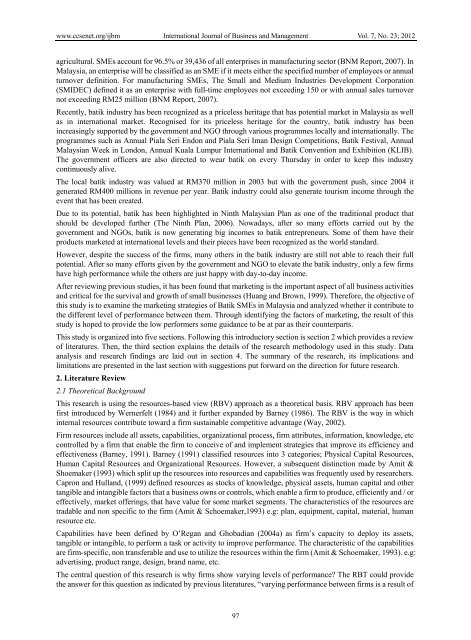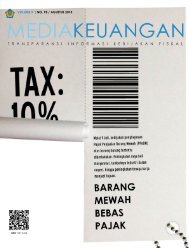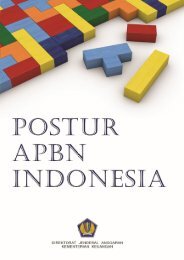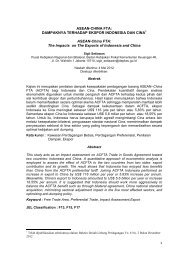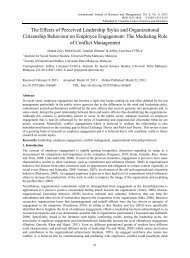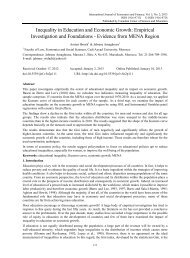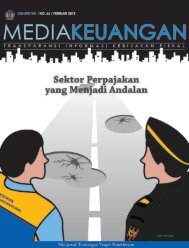Marketing%20Strategies%20and%20the%20Difference%20Level%20of%20Sales%20and%20Profits
Marketing%20Strategies%20and%20the%20Difference%20Level%20of%20Sales%20and%20Profits
Marketing%20Strategies%20and%20the%20Difference%20Level%20of%20Sales%20and%20Profits
Create successful ePaper yourself
Turn your PDF publications into a flip-book with our unique Google optimized e-Paper software.
www.ccsenet.org/ijbm International Journal of Business and Management Vol. 7, No. 23; 2012<br />
agricultural. SMEs account for 96.5% or 39,436 of all enterprises in manufacturing sector (BNM Report, 2007). In<br />
Malaysia, an enterprise will be classified as an SME if it meets either the specified number of employees or annual<br />
turnover definition. For manufacturing SMEs, The Small and Medium Industries Development Corporation<br />
(SMIDEC) defined it as an enterprise with full-time employees not exceeding 150 or with annual sales turnover<br />
not exceeding RM25 million (BNM Report, 2007).<br />
Recently, batik industry has been recognized as a priceless heritage that has potential market in Malaysia as well<br />
as in international market. Recognised for its priceless heritage for the country, batik industry has been<br />
increasingly supported by the government and NGO through various programmes locally and internationally. The<br />
programmes such as Annual Piala Seri Endon and Piala Seri Iman Design Competitions, Batik Festival, Annual<br />
Malaysian Week in London, Annual Kuala Lumpur International and Batik Convention and Exhibition (KLIB).<br />
The government officers are also directed to wear batik on every Thursday in order to keep this industry<br />
continuously alive.<br />
The local batik industry was valued at RM370 million in 2003 but with the government push, since 2004 it<br />
generated RM400 millions in revenue per year. Batik industry could also generate tourism income through the<br />
event that has been created.<br />
Due to its potential, batik has been highlighted in Ninth Malaysian Plan as one of the traditional product that<br />
should be developed further (The Ninth Plan, 2006). Nowadays, after so many efforts carried out by the<br />
government and NGOs, batik is now generating big incomes to batik entrepreneurs. Some of them have their<br />
products marketed at international levels and their pieces have been recognized as the world standard.<br />
However, despite the success of the firms, many others in the batik industry are still not able to reach their full<br />
potential. After so many efforts given by the government and NGO to elevate the batik industry, only a few firms<br />
have high performance while the others are just happy with day-to-day income.<br />
After reviewing previous studies, it has been found that marketing is the important aspect of all business activities<br />
and critical for the survival and growth of small businesses (Huang and Brown, 1999). Therefore, the objective of<br />
this study is to examine the marketing strategies of Batik SMEs in Malaysia and analyzed whether it contribute to<br />
the different level of performance between them. Through identifying the factors of marketing, the result of this<br />
study is hoped to provide the low performers some guidance to be at par as their counterparts.<br />
This study is organized into five sections. Following this introductory section is section 2 which provides a review<br />
of literatures. Then, the third section explains the details of the research methodology used in this study. Data<br />
analysis and research findings are laid out in section 4. The summary of the research, its implications and<br />
limitations are presented in the last section with suggestions put forward on the direction for future research.<br />
2. Literature Review<br />
2.1 Theoretical Background<br />
This research is using the resources-based view (RBV) approach as a theoretical basis. RBV approach has been<br />
first introduced by Wernerfelt (1984) and it further expanded by Barney (1986). The RBV is the way in which<br />
internal resources contribute toward a firm sustainable competitive advantage (Way, 2002).<br />
Firm resources include all assets, capabilities, organizational process, firm attributes, information, knowledge, etc<br />
controlled by a firm that enable the firm to conceive of and implement strategies that improve its efficiency and<br />
effectiveness (Barney, 1991). Barney (1991) classified resources into 3 categories; Physical Capital Resources,<br />
Human Capital Resources and Organizational Resources. However, a subsequent distinction made by Amit &<br />
Shoemaker (1993) which split up the resources into resources and capabilities was frequently used by researchers.<br />
Capron and Hulland, (1999) defined resources as stocks of knowledge, physical assets, human capital and other<br />
tangible and intangible factors that a business owns or controls, which enable a firm to produce, efficiently and / or<br />
effectively, market offerings, that have value for some market segments. The characteristics of the resources are<br />
tradable and non specific to the firm (Amit & Schoemaker,1993) e.g: plan, equipment, capital, material, human<br />
resource etc.<br />
Capabilities have been defined by O’Regan and Ghobadian (2004a) as firm’s capacity to deploy its assets,<br />
tangible or intangible, to perform a task or activity to improve performance. The characteristic of the capabilities<br />
are firm-specific, non transferable and use to utilize the resources within the firm (Amit & Schoemaker, 1993). e.g:<br />
advertising, product range, design, brand name, etc.<br />
The central question of this research is why firms show varying levels of performance? The RBT could provide<br />
the answer for this question as indicated by previous literatures, “varying performance between firms is a result of<br />
97


